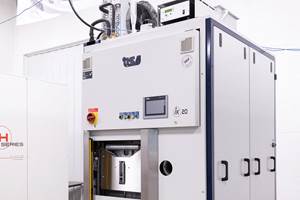Single System Offers Multiple Finishing Processes For Small Parts
An electrochemical finishing technology geared toward small workpieces cleans, deburrs, passivates, polishes and stress relieves workpieces all at once.
Share







ECi Software Solutions, Inc.
Featured Content
View More


Autodesk, Inc.
Featured Content
View MoreAccurate machining is only one piece of the manufacturing puzzle. Machined components, especially those used for medical, scientific, semi-conductor and automotive applications, often require secondary finishing processes for polishing or burr removal before assembly or use. These secondary operations can be challenging for very small parts or parts with delicate features. Mechanical finishing processes have the potential to be damaging, while conventional electropolishing (EP) may not have the capability to remove large burrs. This is often why many shops will outsource this post-machining work.
Extrude Hone (Irwin, Pennsylvania), has developed a new electrochemical finishing technology that can perform five finishing processes in one operation. Geared toward small-parts finishing, the company’s CoolPulse system simultaneously cleans, deburrs, passivates, polishes and stress relieves workpieces. The non-contact system will not damage tiny features, such as thin walls. It offers advantages over traditional EP in that it uses a cool, non-fuming electrolyte solution that is easy to handle. Plus, the system’s relatively small learning curve may lead shops to consider bringing finishing work in-house, where they can have better control over delivery time, part handling and costs.
Like conventional EP, the CoolPulse process immerses workpieces in an electrolyte bath and applies a low-voltage DC charge. However, the CoolPulse process differs from EP in various ways, according to Jim Koroskenyi, managing director of Extrude Hone’s electrochemical business unit. It uses a chilled, high-resistance electrolyte solution with a near-neutral pH level. Because the solution is odorless and non-fuming, it does not require a dedicated ventilation system and is safe to handle. Its high electrical resistance makes it effective for removing burrs and peaks on workpiece surfaces. A filtration system allows the solution to retain its effectiveness over extended periods of operating time, eliminating costs for additional solution or for waste disposal.
The solution is compatible with a variety of materials, including steels, aluminum and magnesium, as well as chrome and cobalt alloys and copper-based alloys. The system accommodates different material types and workpiece sizes through adjustment of parameters such as voltage, pulse, time and temperature. Typical finishing cycle time ranges from 15 seconds for very small parts to 3 minutes for workpieces with large burrs and heavy polishing requirements. Those cycle times are the same for one or multiple parts. This is twice the speed of conventional EP, according to Mr. Koroskenyi.
While CoolPulse is optimized for burr removal, substantial surface and cleanliness improvements are natural by-products of the process. The system produces a mirror-like finish on stainless steel and bright to matte finishes on aluminum.
Mr. Koroskenyi says conventional EP can take considerable training and experience to maintain process control, which is often why shops outsource this these secondary operations. However, this works against the goal of single-part manufacturing, cellular production and minimizing part movement. The CoolPulse system is designed for installation on the shop floor, and the skill set needed to operate the system is said to be comparable to that required to operate a CNC machining center or EDM unit.
So what kind of learning curve would shops having no experience with such finishing equipment face with this system? Mr. Koroskenyi says that shops should first spend two days of theory training and three days of practical demonstration and tooling and process training. After two to three weeks, shops should be able to master the technology for one class of parts. Two to three months later, shops are likely to possess sufficient understanding to finish virtually any type of part.
Related Content
Madison Chemical Degreaser Easily Removes Machining Oil
ProClean Degreaser quickly and completely removes oil and grease with its superior wetting and penetrating properties.
Read MoreAlliance Manufacturing's Cleaning Systems Use Safe Solvents
PMTS: The company’s vacuum degreasing machines use solvents to remove contaminants from manufactured parts without the use of water or scrubbing.
Read MoreParts Cleaning Trends, Equipment and Solvents at IMTS 2024
Trends in solvent replacement and environmentally friendly efforts are featured in this year’s parts cleaning booths.
Read MoreVollmer Ultrasonic Cleaning, Deburring System Provides Process Reliability
IMTS 2024: The UltraTec Ultrasonic A25 cleans and deburrs small and delicate components, making it well suited for applications in heavily regulated sectors with challenging demands.
Read MoreRead Next
Registration Now Open for the Precision Machining Technology Show (PMTS) 2025
The precision machining industry’s premier event returns to Cleveland, OH, April 1-3.
Read MoreBuilding Out a Foundation for Student Machinists
Autodesk and Haas have teamed up to produce an introductory course for students that covers the basics of CAD, CAM and CNC while providing them with a portfolio part.
Read More5 Rules of Thumb for Buying CNC Machine Tools
Use these tips to carefully plan your machine tool purchases and to avoid regretting your decision later.
Read More.png;maxWidth=970;quality=90)




























.png;maxWidth=300;quality=90)


















